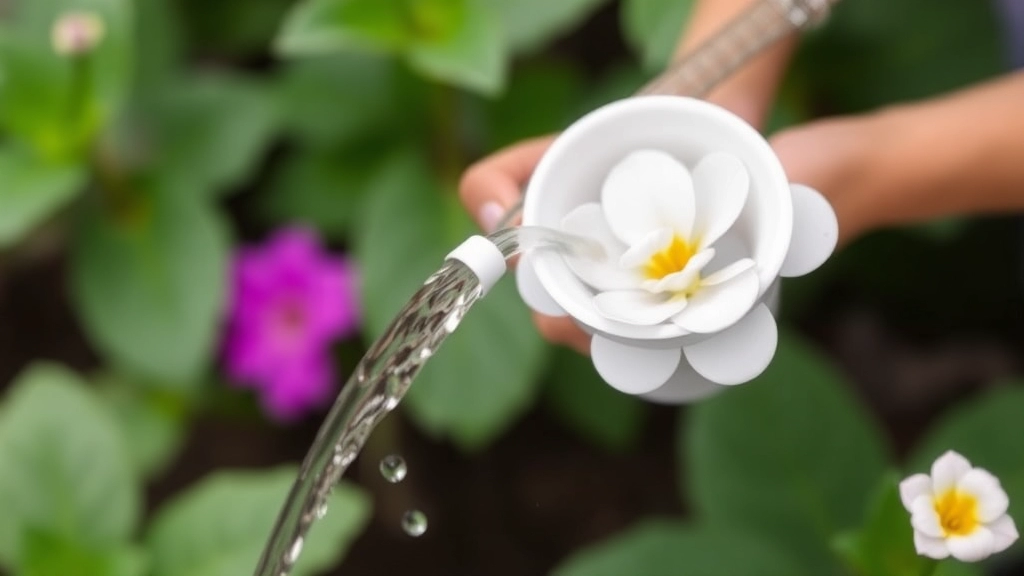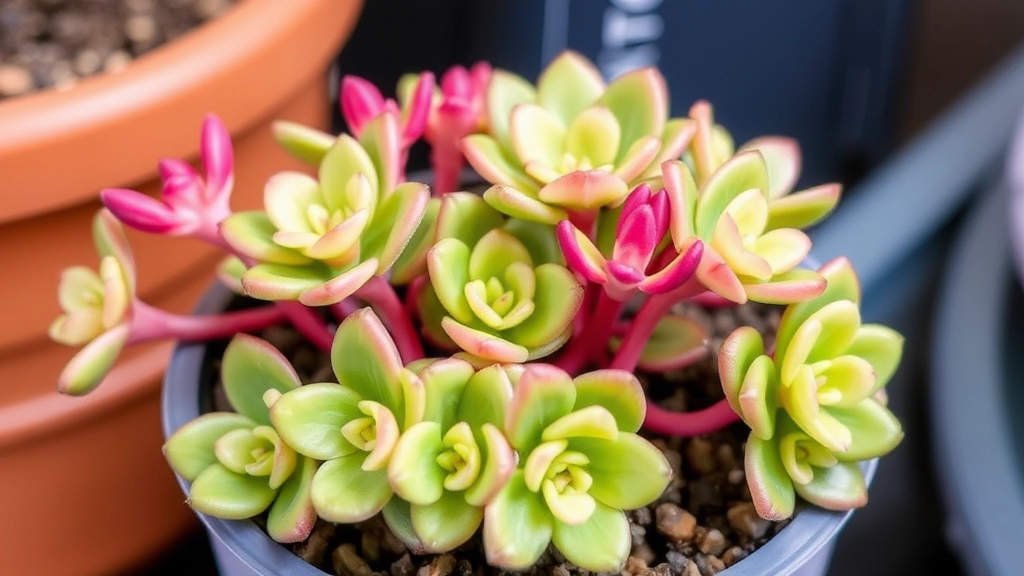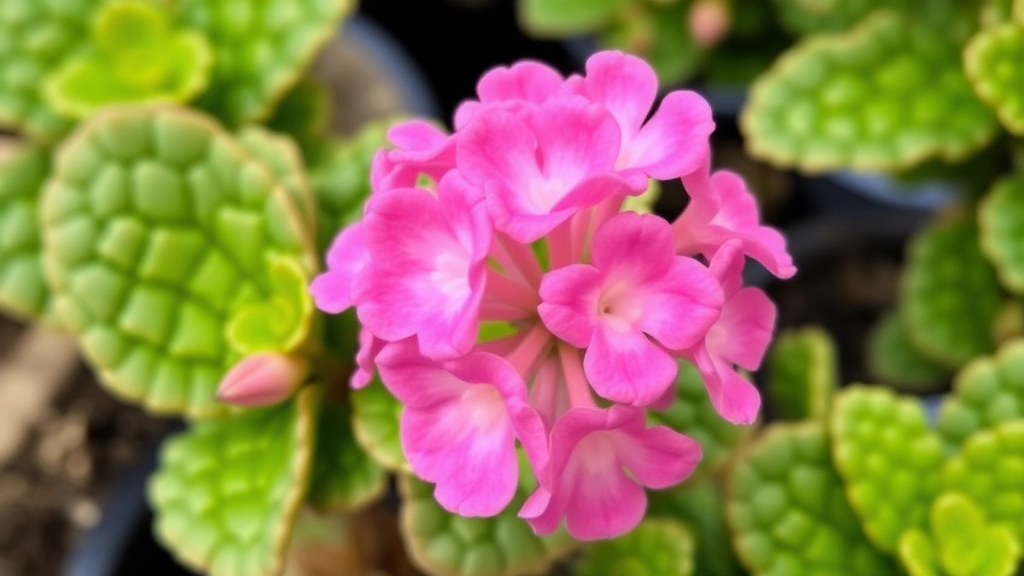Kalanchoe Gastonis Bonnieri Care
Looking to master Kalanchoe Gastonis Bonnieri care? You’re in the right place. This unique succulent, also known as the Donkey Ear plant, thrives with the right balance of light, water, and soil. Let’s dive into how to create the perfect environment for your plant to flourish.
Light Requirements
First, place your Kalanchoe Gastonis Bonnieri in a spot with bright, indirect light. Too much direct sunlight can scorch its leaves.
Watering Tips
Watering is key—let the soil dry out completely between waterings to avoid root rot.
Soil Mix
A well-draining soil mix is essential to keep your plant healthy.
Conclusion
Ready to elevate your plant care game? Let’s explore more tips to keep your Donkey Ear plant thriving year-round.
Light and Placement Requirements for Kalanchoe Gastonis-Bonnieri
When it comes to caring for your Kalanchoe Gastonis-Bonnieri, understanding its light and placement needs is crucial. Many plant enthusiasts often wonder why their plants aren’t thriving, and the answer often lies in inadequate lighting.
Optimal Light Conditions
Kalanchoe Gastonis-Bonnieri thrives in bright, indirect sunlight. Here’s how to ensure your plant gets the right amount of light:
- Location: Place your Kalanchoe near a south-facing window where it can receive ample light.
- Avoid Direct Sunlight: While it loves light, direct sun can scorch its leaves. Aim for filtered sunlight, especially during peak hours.
- Supplemental Lighting: If natural light is limited, consider using grow lights to provide the necessary illumination.
Signs of Improper Lighting
Recognising the signs of insufficient or excessive light can help you adjust your plant’s placement:
- Too Little Light: If the leaves become leggy or pale, it’s a sign your plant needs more light.
- Too Much Light: Brown, crispy leaf edges indicate that your Kalanchoe is getting too much direct sunlight.
To ensure your Kalanchoe Gastonis-Bonnieri flourishes, keep an eye on its light conditions. For more detailed tips, check out our Essential Kalanchoe Care Tips for Summer Success.
Seasonal Adjustments
As seasons change, so do light levels. Here’s how to adapt:
- Summer: If your plant is outside, consider providing some shade during the hottest part of the day.
- Winter: Move your Kalanchoe closer to windows to maximise the available light. For more information on seasonal care, refer to our Winter Care Tips for Healthy Kalanchoe Plants.
Watering Needs: Finding the Right Balance

So, you’ve got your Kalanchoe Gastonis-Bonnieri, and now you’re wondering how much water it really needs, right?
Finding that sweet spot can be tricky. Overwater it, and you risk root rot. Underwater it, and those beautiful leaves might start to droop.
The Watering Checklist
- Frequency: Generally, watering every 2-3 weeks is a good rule of thumb.
- Soil Check: Before you water, stick your finger about an inch into the soil. If it’s dry, it’s time to water.
- Watering Method: Water deeply but infrequently. Give it a good soak until water drains out of the bottom.
Signs of Trouble
- Overwatering: Yellowing leaves or mushy stems? That’s a red flag.
- Underwatering: If the leaves are shriveling or dropping, your plant is thirsty.
Seasonal Adjustments
- In the growing season (spring and summer), your Kalanchoe may need a bit more water.
- During the dormant months (fall and winter), cut back on watering.
Soil Selection and Drainage Considerations
When caring for Kalanchoe Gastonis-Bonnieri, the right soil is crucial for its health and growth. You might be wondering, “What type of soil should I use?” or “How do I ensure proper drainage?”
Choosing the Right Soil Mix
Kalanchoe Gastonis-Bonnieri thrives in well-draining soil. Here are some options to consider:
- Cactus Mix: A pre-made cactus mix is often ideal, as it provides excellent drainage.
- Homemade Mix: You can create your own by combining:
- 50% potting soil
- 25% perlite
- 25% coarse sand
This combination ensures that the soil retains some moisture while allowing excess water to escape.
Drainage is Key
Proper drainage is essential to prevent root rot, a common issue for Kalanchoe. Here’s how to ensure your plant has the best drainage:
- Choose the Right Pot: Use pots with drainage holes. This allows excess water to escape easily.
- Add Drainage Material: Consider placing small stones or gravel at the bottom of the pot before adding soil. This creates a barrier that helps water flow out.
Signs of Poor Soil Conditions
Keep an eye out for these signs that your Kalanchoe may be struggling with soil issues:
- Yellowing Leaves: This can indicate overwatering or poor drainage.
- Wilting: If your plant appears droopy despite adequate watering, it may be sitting in soggy soil.
By selecting the right soil and ensuring proper drainage, you set your Kalanchoe Gastonis-Bonnieri up for success. For more detailed advice on how to propagate Kalanchoe, check out our step-by-step guide to growing Kalanchoe from leaf cuttings. Additionally, understanding the optimal temperature conditions can further enhance your plant’s growth and health.
Temperature Tolerance and Seasonal Adjustments

As we delve deeper into nurturing Kalanchoe Gastonis-Bonnieri, understanding its temperature tolerance is essential for thriving growth. Many plant enthusiasts often wonder: “What temperatures are best for my Kalanchoe?”
Kalanchoe Gastonis-Bonnieri prefers a warm environment, thriving best in temperatures ranging from 20°C to 25°C (68°F to 77°F).
However, it can tolerate a broader range:
- Minimum Temperature: 10°C (50°F) – Below this, growth may slow, and the plant could suffer.
- Maximum Temperature: 30°C (86°F) – While it can handle the heat, extreme temperatures can lead to stress.
Seasonal Adjustments
Adjusting care according to the seasons can significantly enhance your plant’s health. Here’s how to adapt:
- Spring and Summer:
- Maintain warmer temperatures.
- Ensure the plant receives ample sunlight, ideally 6 hours of indirect light daily.
- Water more frequently as the plant actively grows.
- Autumn and Winter:
- Gradually lower temperatures to around 15°C (59°F) to encourage dormancy.
- Reduce watering to prevent root rot; the plant will need less moisture during this time.
- Place it in a brighter spot if possible, as daylight hours decrease.
Quick Tips for Temperature Management
- Avoid Drafts: Keep your Kalanchoe away from cold drafts or heat sources like radiators.
- Use a Thermometer: A simple thermometer can help you monitor the temperature in your plant’s environment.
- Humidity Levels: While Kalanchoe prefers dry conditions, maintaining a slightly humid environment can be beneficial during colder months.
Common Pests and How to Prevent Them
As we delve deeper into caring for Kalanchoe Gastonis-Bonnieri, it’s crucial to address a common concern: pests.
Many plant enthusiasts worry about the impact of pests on their beloved succulents.
Common Pests
- Mealybugs
- Small, white, cotton-like insects.
- Often found in leaf joints and on stems.
- Aphids
- Tiny, green or black bugs that cluster on new growth.
- They suck sap, weakening the plant.
- Spider Mites
- Tiny, red or yellow mites that create fine webs.
- They thrive in dry conditions.
- Scale Insects
- Small, hard bumps on stems and leaves.
- They can be difficult to spot but cause significant damage.
Prevention Strategies
Keeping your Kalanchoe Gastonis-Bonnieri healthy is the best way to prevent pests. Here are some effective strategies:
- Regular Inspections
- Check your plant weekly for any signs of pests.
- Early detection can prevent infestations.
- Maintain Proper Watering
- Overwatering can create a habitat for pests.
- Ensure the soil dries out between waterings.
- Improve Air Circulation
- Place your plant in a location with good airflow.
- This can deter spider mites and other pests.
- Use Neem Oil
- A natural pesticide that can be sprayed on affected areas.
- It disrupts the life cycle of pests without harming the plant.
- Keep Surroundings Clean
- Remove dead leaves and debris from around the plant.
- This reduces hiding spots for pests.
By implementing these preventive measures, you can significantly reduce the risk of pest infestations. For more detailed care, check out our Kalanchoe Paddle Plant Care Guide and learn about the treatment for black spots on Kalanchoe leaves.
Propagating Kalanchoe Gastonis-Bonnieri Successfully

So, you’ve got your Kalanchoe Gastonis-Bonnieri thriving, and now you’re wondering how to multiply that beauty. Propagation can seem daunting, but trust me, it’s easier than you think!
Why Propagate?
Maybe you want to share the love with friends, or perhaps you just want more of these stunning plants around your home. Whatever your reason, let’s dive into the nitty-gritty of propagation.
Methods of Propagation
You’ve got a couple of easy options here:
- Leaf Cuttings: Snip a healthy leaf off your plant. Let it dry for a day or two to form a callus. Then, place it in well-draining soil. Water sparingly until you see new growth.
- Offsets: If your Kalanchoe is mature, it might produce little offsets or pups. Gently separate these from the main plant and pot them in their own containers.
Tips for Success
- Timing: The best time to propagate is during the growing season, typically spring or early summer. They’re more active and likely to root quickly.
- Humidity: Keep the cuttings in a humid environment. A plastic bag or a mini greenhouse can work wonders.
- Light: Place them in bright, indirect light. Too much direct sun can scorch those delicate new leaves.
- Patience: It can take a few weeks for roots to develop, so don’t rush the process. Check occasionally but avoid disturbing the cuttings too much.
VII. Pruning and Maintenance for Optimal Growth
When it comes to ensuring your Kalanchoe Gastonis-Bonnieri thrives, pruning and maintenance play a vital role.
Many plant enthusiasts often wonder: How do I keep my Kalanchoe looking its best?
Pruning not only helps shape the plant but also promotes healthy growth. Here are some essential tips to keep in mind:
- Timing is Key:
- Prune in early spring, just before the growing season begins.
- This encourages new growth and flowering.
- What to Remove:
- Snip off any dead or yellowing leaves.
- Trim back leggy stems to encourage bushier growth.
- Technique Matters:
- Use clean, sharp scissors to avoid damaging the plant.
- Make cuts just above a leaf node to promote new growth.
- Frequency:
- Regular checks every few months will help maintain its shape.
- Aim for light pruning rather than heavy cuts.
In addition to pruning, consistent maintenance is crucial.
Here are some maintenance tips to keep your Kalanchoe healthy:
- Dusting Leaves:
- Wipe leaves gently with a damp cloth to remove dust.
- This allows the plant to photosynthesize efficiently.
- Fertilizing:
- Use a balanced, water-soluble fertilizer during the growing season.
- Feed every 4-6 weeks for optimal results.
- Monitoring Health:
- Keep an eye out for signs of stress, such as wilting or discoloration.
- Address issues promptly to prevent further damage.
By following these pruning and maintenance tips, your Kalanchoe Gastonis-Bonnieri will flourish beautifully. For more detailed guidance, check out our Complete Guide to Harpoon Leaf Kalanchoe Care & Propagation and learn how to Propagate Leggy Kalanchoe effectively.
Potting and Repotting: Best Practices
So, you’ve got your Kalanchoe Gastonis-Bonnieri thriving, and now you’re wondering about potting and repotting. It’s a common concern for plant lovers, and getting it right can make all the difference in your plant’s health.
When to Repot?
Timing is everything.
- Spring is your best bet: This is when your plant is waking up from dormancy.
- Look for roots: If you see roots poking out of the drainage holes or if the plant seems top-heavy, it’s time for a new pot.
Choosing the Right Pot
Not all pots are created equal. Here’s what to keep in mind:
- Size matters: Choose a pot that’s 1-2 inches larger in diameter than the current one.
- Drainage holes: Ensure it has good drainage to prevent waterlogging. Kalanchoes hate sitting in water!
- Material choices: Terracotta is great for breathability, while plastic pots retain moisture longer.
Soil Selection
The right soil can make a world of difference.
- Well-draining mix: A cactus or succulent mix is ideal. For more information, check out our complete care guide for Kalanchoe Flaming Katy.
- Add some grit: Mixing in perlite or sand can improve drainage even further.
Repotting Steps
Let’s break it down into simple steps:
- Prepare your new pot: Add a layer of fresh soil to the bottom.
- Gently remove the plant: Tap the sides of the pot and ease it out.
- Loosen the roots: If they’re tightly bound, gently tease them apart.
- Place in the new pot: Position the plant in the center and fill in with soil.
- Water lightly: Just a bit to settle the soil; don’t soak it. For watering tips, you might find our outdoor Kalanchoe care guide helpful.
Aftercare Tips
Once you’ve repotted, keep an eye on your plant:
- Avoid direct sunlight for a week to help it adjust.
- Monitor moisture levels: Don’t water too soon; let it settle in.
FAQs on Kalanchoe Gastonis-Bonnieri Care
How often should I water my Kalanchoe Gastonis-Bonnieri?
Watering every 2-3 weeks is generally a good rule of thumb. Always check the soil moisture by sticking your finger about an inch into the soil; if it’s dry, it’s time to water.
What are the signs of overwatering and underwatering?
Overwatering can cause yellowing leaves or mushy stems, while underwatering can lead to shriveling or dropping leaves.
What temperatures are ideal for Kalanchoe Gastonis-Bonnieri?
This plant thrives best in temperatures ranging from 20°C to 25°C (68°F to 77°F), but it can tolerate a broader range from 10°C (50°F) to 30°C (86°F).
How should I adjust care according to the seasons?
Spring and Summer: Maintain warmer temperatures, provide ample sunlight (ideally 6 hours of indirect light daily), and water more frequently.
Autumn and Winter: Gradually lower temperatures to around 15°C (59°F), reduce watering, and place the plant in a brighter spot if possible.
What are the methods of propagating Kalanchoe Gastonis-Bonnieri?
You can propagate via leaf cuttings or offsets. For leaf cuttings, snip a healthy leaf, let it dry to form a callus, and then plant it in well-draining soil. For offsets, gently separate them from the main plant and pot them in their own containers.
When is the best time to propagate?
The best time to propagate is during the growing season, typically spring or early summer, as the plant is more active and likely to root quickly.
How can I ensure successful propagation?
Keep the cuttings in a humid environment, place them in bright, indirect light, and be patient as it can take a few weeks for roots to develop.
What should I avoid to keep my Kalanchoe healthy?
Avoid cold drafts, extreme heat sources, and overwatering. Using a thermometer to monitor the temperature and maintaining a slightly humid environment during colder months can also be beneficial.
References
-
Kalanchoe Gastonis-Bonnieri Profile
-
Caring for Kalanchoe Gastonis-Bonnieri
-
Kalanchoe Gastonis-Bonnieri Plant Care
